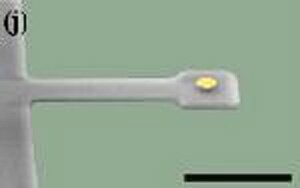Thu 15 Apr 2004

A small gold dot rests on a silicon cantilever. The dot is a test mass for studying how the cantilever can be used to measure the masses of tiny particles, including viruses, with attogram precision. (Image credit: Physics News Update 673 #2) (via BoingBoing)
Phil Schewe, James Riordon, and Ben Stein, Physics News Update 673 #2, write:
Attogram mass detection has been achieved by Harold Craighead and his colleagues at Cornell, with prospects of exquisite detection of very tiny chemical and biological species, possibly with arrays of detectors. With their lithographically fabricated nanoelectromechanical (NEMS) device, the Cornell researchers can measure the mass of a particle with a sensitivity of 10-18 grams, far exceeding the precision of a comparable device with femtogram (10-15 g) sensitivity reported last year (Update 634-2). To get any better measurement of mass you would have to vaporize the particle and shoot its constituent molecules through a mass spectrometer.
At Cornell, mass measurement works this way: when the minuscule particle is absorbed onto a tiny sliver of silicon it alters the sliver’s resonant oscillation (see figure). The oscillation in turn is monitored by reflecting laser light off the cantilever. It’s as if a particle with a mass of a billionth of a billionth of a gram stepped onto a diving board whose springiness was observed by reflected light.
So far Craighead’s group has weighed small gold dots and tiny coatings of molecules on the dots, but the goal is to detect and identify viruses. (Previously the same group detected the immunospecific binding of a single bacterium using the oscillating-cantilever method. They did this by coating their with a specific antibody and therefore could bind and detect the added mass only of the corresponding antigen.)
The mass sensitivity with the present cantilever (4 microns long, 500 nm wide, and at room temperature) is expected to be 0.39 attogram and will only get better as the size of the cantilever is reduced further, extending the sensitivity well into the zeptogram (10-21 g) range. (Ilic et al., Journal of Applied Physics, upcoming article; also, see lab website. For an analysis of the ultimate limits of cantilever sensing of mass, see Ekinci et al., Journal of Applied Physics, 1 March 2004.)